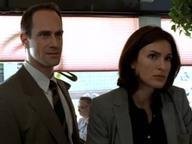Quiz Answer Key and Fun Facts
1. In Season 13's "The Ring", ADA Southerlyn has an epiphany during a conversation with a newsstand operator from the first of the twin towers that fell on 9/11. This solves the case. What does the ADA suddenly realize that puts a whole new light on the case?
2. In the season 13 episode "Absentia", Mandy Patinkin guest stars as a killer who has been on the run for more than two decades. He has a peculiar nickname. What is it?
3. A season 15 episode, "Fixed", is a follow-up to the season 1 episode called "Indifference", which was based on the Lisa Steinberg case.
In "Fixed", a parolee is hit by a car that seemed to be aiming for him, and loses a body part as a result of the accident. What body part does he lose?
4. A season 15 episode called "Fluency" is about people who are murdered by way of dying from the flu after receiving a counterfeit vaccine made of a solution that is designed not to harm the recipient, but essentially doesn't do anything, and especially doesn't prevent the current influenza people expect to be immunized for. What is in the vials?
5. "Dining Out" is a season 15 episode; a TV producer of a cooking show is murdered after a charity function. Early suspects are identical twins who run the charity, which is revealed to have questionable financial practices. Detective Fontana is not well-versed in the biology of identical twins; what does Detective Green have to explain to him?
6. The season 16 episode "Ghosts" is the first to showcase Dennis Farina as Det. Fontana, by showing him pursuing a cold case. He serendipitously overhears the spontaneous deathbed confession of a robber, to the kidnapping of a young girl, and recognizes the name of the girl as the center of a case Fontana had worked on 10 years earlier. Fontana had been certain a family member was involved, and had hounded that person until making a bad enemy of someone whose cooperation he now needed. Who had Fontana considered guilty?
7. In a season 17 episode called "Remains of the Day", that opens with characters based on Anna Nicole Smith and her son, quickly takes twists that veers away from her life. A young man visiting his mother in the hospital has a sudden seizure and dies. The seizure is traced to a problem with a femur graft he had after a car accident. What was the ME's first clue linking the seizure to the bone graft?
8. In "Charity Case", a season 17 episode, a white American celebrity couple has adopted a baby from Africa. After several months, the baby's father shows up to visit his son, a right which he claims he was promised, and so far the promise has not been upheld. The adopting couple claim they want to bond thoroughly with the baby first. They actually have a much more sinister motive. What is it?
9. In "Pledge", during season 19, a man, Ned Lasky, is obsessed with women in sororities, and one sorority especially. It turns out that he was asked to leave a party at that sorority back when he was in college. The sorority sisters had an expression for getting rid of men they didn't think belonged at the party. What is the expression?
10. "Doped" aired in season 20. A manager of a pharmaceutical company spikes a smoothie with alcohol so an employee will be arrested for drunk driving, and thus be discredited and fired. As a back-up, he also plants a powerful drug that will disorient her in another delivery system. Where was the second drug hidden?
Source: Author
RivkahChaya
This quiz was reviewed by FunTrivia editor
guitargoddess before going online.
Any errors found in FunTrivia content are routinely corrected through our feedback system.


